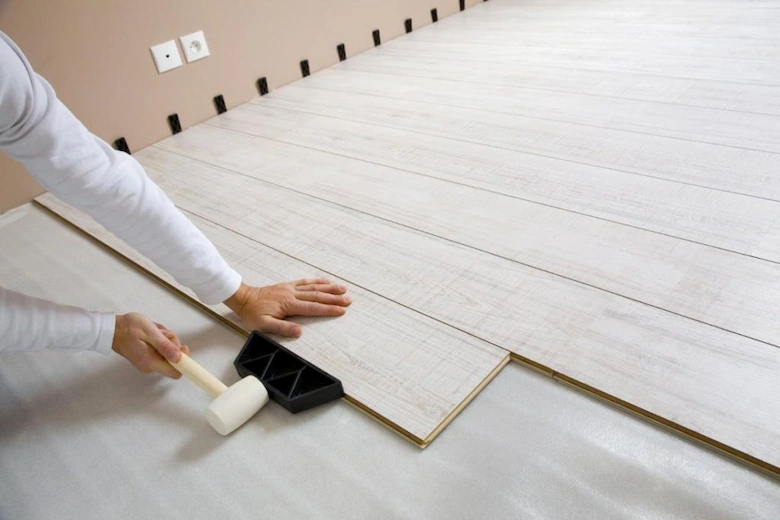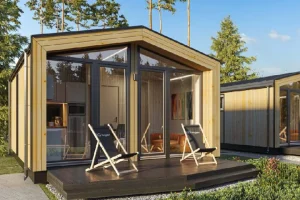Wood has long been one of the main materials used to build shelters for humans. This element is still widely used today due to its many properties, the most important of which are its long lifespan and high resistance. Today, in this article, we are going to examine the role of wood in Iranian architecture. So, don’t miss this article and follow us until the end.
The role of wood in Iranian architecture
Wood, as one of the natural and ancient materials, has played a very important role in Iranian architecture. With its unique properties, including strength, flexibility and natural beauty, this material has become one of the main materials in the construction of Iranian buildings. In different eras, wood has been used to make all kinds of doors, windows, ceilings and even columns. In Iranian architecture, wood has played a vital role not only in the technical structure of buildings, but also in interior and exterior decorations.
The history of the use of wood in Iranian architecture dates back to ancient times, especially in the Sasanian era and before that in the Achaemenid era, when wood was used as a widely used material in the construction of large buildings. The use of wood in architecture also reached its peak during the Islamic era of Iran. Intricate and elegant designs in wooden doors, lattice windows and wooden ceilings are prominent features of Iranian Islamic architecture that can still be seen in many historical monuments.


Wood in traditional Iranian architecture
Wood has been used in traditional Iranian architecture as an efficient and beautiful element in the design of spaces due to its adaptability to different climates, from mountainous areas to hot and dry areas. In this type of architecture, wood was usually used for the internal structures of houses, including doors, windows and ceilings. In addition, in many traditional Iranian houses, wood was used to make lattices and sashes (colored wooden windows), which, in addition to creating beautiful lighting, also helped to ventilate and cool the houses.
One of the clear examples of the use of wood in traditional Iranian architecture is the historic houses in the cities of Yazd and Kashan. These houses, which are often built in desert areas, are in some way in harmony with the hot and dry climate by using wood in the ceilings, doors and windows. Wood in these spaces not only helped create a sense of warmth and comfort, but also brought a certain beauty and harmony to the living environment of Iranians with its unique designs.
Characteristics of wood in Iranian architecture
Wood has been used in Iranian architecture since ancient times due to its unique characteristics, including lightness, malleability, strength, and natural beauty. In Iranian architecture, this natural material is used in a way that can provide both aesthetic and functional aspects of buildings. Wood can easily withstand different weather conditions and add more beauty to Iranian architectural spaces with unique designs.
In many historical monuments in Iran, wood has been used for large and important structures such as gates, columns, and inscriptions. One of the notable features of wood in Iranian architecture is the use of geometric designs and decorative arts on the surface of the wood, which makes the buildings visually attractive. In addition, in religious and historical buildings such as mosques and tombs, wood has been used as a material that can easily be transformed into decorative art, in the construction of domes, altars, and entrance doors.
In contemporary Iranian architecture, wood continues to be a popular and sought-after material that is used in combination with new materials, especially in residential and commercial buildings. Iranian architects are trying to preserve the spirit of Iranian architectural traditions in modern designs by using wood. In this era, in addition to its decorative aspects, wood is used as a practical and green material in building design to help reduce energy consumption and conserve natural resources as an environmentally friendly material.
In contemporary Iranian architecture, wood is used in interior spaces as a warm and pleasant material. The use of wood in interior decoration, ceilings, and interior walls, while preserving Iran’s cultural and traditional identity, gives the space of modern Iranian homes a natural and calming feel. Given that wood has had a prominent presence in Iranian architecture from the past to the present, its use in contemporary architecture is a bridge between the past and the present, tradition and modernity, which helps preserve the identity of Iranian architecture.
Introduction to the various uses of wood in Iranian buildings
In Iranian architecture, wood is used as one of the primary and main materials in various applications. From the main structures of buildings such as ceilings, columns and gates to interior decorations such as wooden doors, windows and sashes, wood has played a special role in shaping Iranian architectural designs. The use of wood in the exterior facades of buildings, especially in areas that require temperature control, has been used in accordance with different climates as a natural method to create a sense of coolness and air conditioning.
One of the outstanding features of the use of wood in Iranian buildings is its ability to create harmony with other building materials. In some buildings, wood is combined with brick, stone and plaster to create a resistant and beautiful structure. These combinations, in addition to strength, give a special artistic sense to architectural spaces. For example, in Safavid palaces or large mosques such as the Shah Mosque of Isfahan, the use of wood in windows and ceilings, along with colored tiles and geometric patterns, has created a lasting image of Iranian architectural art.
How has wood helped strengthen the identity of Iranian architecture?
Wood has appeared in Iranian architecture not only as a structural material but also as a cultural and identity element in Iranian architecture. The use of wood in the interior and exterior decorations of buildings, along with traditional Iranian designs, has strengthened the cultural and artistic identity of this country. This natural element, especially during the Islamic era of Iran, was wonderfully combined with decorative arts such as stucco, tiling, and murals to display Iranian cultural and religious symbols in architectural spaces.
In many Iranian buildings, wood was used as a symbolic element to communicate with nature and create a sense of harmony with the environment. Especially in Iranian gardens, which are among the most important works of Iranian architecture, wood is present as an inseparable part of structural and decorative designs. Trees, wooden doors, and other natural elements in these spaces not only create a beautiful appearance but also symbolize life and renewal, a concept that is present in many aspects of Iranian culture.
The role of wood in Iranian architectural decorations
Wood has a special place in Iranian architectural decorations and has been used to create intricate and beautiful details in the interior and exterior spaces of buildings. In different eras, wood has been used to make carved doors and windows, colored sashes, and plastered ceilings. These decorations not only helped to create a pleasant and beautiful space, but also played a role as an artistic element in displaying Iranian cultural identity.
One of the most famous uses of wood in Iranian architectural decorations is the construction of carved doors, which display high beauty and precision with geometric designs and natural shapes. These doors were used in mosques, houses, and caravanserais and were made with special care and skill. In this type of architecture, wood was not only used structurally, but was also known as a decorative art that, in addition to beauty, also gave a special meaning to architectural spaces.
Iranian wood and structures
Wood has long been used in Iranian structures and has played a key role in the unique designs of many Iranian buildings. Especially in the mountainous and northern regions of Iran, where access to stone and brick was more limited, wood was used as a primary material to build durable and beautiful structures. In certain designs, such as latticed wooden ceilings and wooden sashes, this natural material was used as a main element in stabilizing the structure of the building and also providing beauty to the space.
In historical buildings such as Safavid and Qajar palaces, wood has been present in unique designs in various parts such as doors, windows and walls. These types of designs usually display a sign of Iranian art and culture by emphasizing artistry and attention to detail. Also, in some buildings, such as mosques and historical schools, the use of wood in high ceilings and elegant columns has created a spiritual and respectful atmosphere for worship and education.
The most popular wooden elements in Iranian interior decoration and architecture
Wooden acoustic wall covering
Wooden acoustic wall covering are one of the most popular and practical options for improving the sound quality and beauty of interior spaces. These types of wall coverings are made of natural wood or wood products, and due to their special structure, they can absorb sound waves and prevent sound reflection. Using these wall coverings in public spaces such as cinemas, recording studios, offices and homes reduces noise and creates acoustic tranquility. In addition to acoustic properties, wooden wall coverings with diverse designs and the ability to adapt to a variety of interior decoration styles give a warm and natural look to the environment.
One of the important advantages of wooden acoustic wall coverings is their easy installation and long life. These products are a suitable option for various environments due to the use of high-quality wood and moisture- and heat-resistant coatings. These wall coverings are also environmentally friendly and recyclable materials are used in their production process. By choosing wooden acoustic wall coverings, you can not only improve the acoustic quality of the environment, but also achieve the design of a beautiful and functional space.

Wooden thermowall
Wooden thermowall is a modern and durable type of wall covering that is produced from natural wood under a thermal process. This process, known as thermowood, increases the durability and resistance of wood to moisture, heat, and insects. Thermowalls, with their diverse designs and precise grooves, are a stylish option for use on interior and exterior walls of buildings. Due to their thermal and acoustic insulation properties, these products have a simultaneously aesthetic and functional role and help optimize energy consumption.
Wooden thermowalls are an excellent choice for renovating and renovating various spaces due to their light weight and easy installation. These wall coverings can give a modern or traditional look to the environment by using different colors or maintaining the natural color of the wood. In addition, wooden thermowall is a long-lasting and cost-effective option for creating a special and attractive effect in interior and exterior architecture due to its high durability and resistance to environmental conditions.

Parquet
Parquet is one of the most popular types of wooden flooring, which is very popular in the interior design of homes and workplaces due to its beautiful appearance and warm and natural feel. Parquet is made of natural wood and has attractive and diverse patterns such as checkered, zigzag and straight that add a special beauty to the space. This type of flooring is not only eye-catching in appearance, but also provides a calm and pleasant environment due to its thermal and acoustic insulation properties.
Parquet is durable and long-lasting due to its solid structure and can maintain its beauty for years with simple care such as using wood wax. This flooring is also relatively resistant to cold, heat and impact. Parquets are available in matte, semi-gloss and glossy types and can be coordinated with different interior decoration styles. By choosing parquet, you can create a luxurious and pleasant space in your home or workplace.

Thermowood flooring
Thermowood flooring is a type of wood flooring that is produced from natural wood processed under high heat. This process increases the wood’s resistance to moisture, fungi, insects and various weather conditions. Thermowood flooring is a suitable choice for indoor spaces such as bedrooms, living rooms and even outdoor environments such as terraces and balconies due to its natural and warm appearance. These floors have attractive colors and textures that can give any space a sense of nature and relaxation.
One of the key advantages of Thermowood flooring is its high resistance to temperature and humidity changes, which makes it an ideal option for humid and humid areas. In addition, this type of flooring is also economically viable due to its easy installation, simple maintenance and long lifespan. Thermowood flooring, with its modern and natural design, can be used as an attractive and durable option for residential and commercial spaces.

Final Words
As you can see, in this article, we have examined the role of wood in Iranian architecture from 0 to 100. We learned that this element has been widely used from the past to the present due to its many benefits and uses. We thank you for your support until the end of this article, and we hope that the information provided will be useful to you. Ohaddeco Group specializes in the design and sale of various types of wooden acoustic wall coverings, as well as the design and implementation of LSF structure. You, our esteemed companions, can contact our experts through the communication bridges for more information and free consultation.




